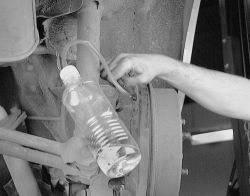
On vehicles equipped with anti-lock brakes (ABS), please refer to the appropriate procedure, later in this section.
If any maintenance or repairs were performed on the brake system, or if air is suspected in the system, the system must be bled. If the master cylinder has been replaced, overhauled or if the fluid reservoir was run dry, start the bleeding procedure with the master cylinder. Otherwise (and after bleeding the master cylinder), start with the wheel cylinder which is farthest from the master cylinder (longest hydraulic line).
MASTER CYLINDER
- Check the fluid level in the master cylinder reservoir and add fluid as required to bring to the proper level.
- Loosen the two brake tubes from the master cylinder.
- Have an assistant depress the brake pedal and hold it in the down position.
- While the pedal is depressed, tighten the fluid lines and then release the brake pedal.
- Repeat the procedure three or four times.
- Bleed the brake system, if needed.
BRAKE SYSTEM
Start the brake system bleeding procedure on the wheel cylinder that is the furthest away from the master cylinder. To bleed the brakes you will need a supply of clean brake fluid, a long piece of clear vinyl tubing and a small container that is half full of clean brake fluid.

 |  |
Fig. Fig. 1: Attach a hose to the bleeder screw and submerge the other end into a clear container to catch the brake fluid
- Clean all the dirt and grease from the bleeder plugs and remove the protective caps. Connect one end of a clear vinyl tube to the fitting.
- Insert the other end of the tube into a jar which is half filled with clean brake fluid.
- Have an assistant slowly depress the brake pedal while you open the bleeder plug 1/3-1/2 of a turn. Fluid should run out of the tube. When the pedal is at its full range of travel, close the bleeder plug.
- Have your assistant slowly pump the brake pedal. Repeat Step 3 until there are no more air bubbles in the fluid.
- Repeat Steps 1 to 4 for each bleeder plug. Add brake fluid to the master cylinder reservoir as necessary, so that it does not completely drain during bleeding.